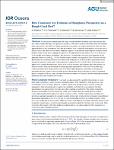How Consistent Are Estimates of Roughness Parameters on a Rough Coral Reef?
| dc.contributor.author | Lindhart, M | |
| dc.contributor.author | Monismith, SG | |
| dc.contributor.author | Khrizman, A | |
| dc.contributor.author | Mucciarone, D | |
| dc.contributor.author | Dunbar, R | |
| dc.date.accessioned | 2023-10-11T13:53:32Z | |
| dc.date.available | 2023-10-11T13:53:32Z | |
| dc.date.issued | 2021-12 | |
| dc.identifier.issn | 2169-9275 | |
| dc.identifier.issn | 2169-9291 | |
| dc.identifier.other | ARTN e2021JC017825 | |
| dc.identifier.uri | https://pearl.plymouth.ac.uk/handle/10026.1/21379 | |
| dc.description | © 2021. American Geophysical Union. All Rights Reserved. | |
| dc.description.abstract |
Coral reefs are hydrodynamically rough, creating turbulent boundary layers that transport and mix various scalars that impact reef processes and also can be used to monitor reef health. Often reef boundary layer characteristics derived from a single instrument are assumed to accurately represent the study site. This approach relies on two assumptions: first, that the boundary layer is relatively homogeneous across the area of interest, and second, that two instruments displaced in space or with different spatiotemporal resolution would produce similar results when sampling the same flow. We deployed four velocimeters over a 15 × 20 m reef at 10 m depth in the Chagos Archipelago. The site had a 1 m tidal range, and waves were primarily locally generated wind waves with Hrms < 0.5 m. Depth-averaged currents were typically 0.2 m/s. Friction velocities derived directly from Reynolds stress measurements by fitting the law of the wall show agreement between instruments (pairwise coefficients of determination R2 ranged from 0.53 to 0.86). Thus, the boundary layer appears to be spatially homogeneous, at least at the scale of our array, and it appears that in the present case friction velocities from one instrument are indeed generally representative of the site. We calculate drag coefficients using curve-fitting and Structure-from-Motion photogrammetry, and while we find general agreement between estimates one instrument in particular produces drag coefficients an order of magnitude larger in comparison. Hence, some variability between instruments was observed, notably when high-resolution instruments measured localized flow features. | |
| dc.language | en | |
| dc.publisher | American Geophysical Union (AGU) | |
| dc.subject | Coral reef | |
| dc.subject | Boundary layer | |
| dc.subject | Roughness | |
| dc.subject | Friction velocity | |
| dc.subject | Drag coefficient | |
| dc.title | How Consistent Are Estimates of Roughness Parameters on a Rough Coral Reef? | |
| dc.type | journal-article | |
| dc.type | Article | |
| plymouth.issue | 12 | |
| plymouth.volume | 126 | |
| plymouth.publication-status | Published | |
| plymouth.journal | Journal of Geophysical Research: Oceans | |
| dc.identifier.doi | 10.1029/2021jc017825 | |
| plymouth.organisational-group | |Plymouth | |
| plymouth.organisational-group | |Plymouth|Faculty of Science and Engineering | |
| plymouth.organisational-group | |Plymouth|Faculty of Science and Engineering|School of Biological and Marine Sciences | |
| plymouth.organisational-group | |Plymouth|REF 2021 Researchers by UoA | |
| plymouth.organisational-group | |Plymouth|Users by role | |
| plymouth.organisational-group | |Plymouth|Users by role|Academics | |
| plymouth.organisational-group | |Plymouth|REF 2021 Researchers by UoA|UoA07 Earth Systems and Environmental Sciences | |
| dcterms.dateAccepted | 2021-11-08 | |
| dc.date.updated | 2023-10-11T13:53:14Z | |
| dc.rights.embargodate | 2023-11-10 | |
| dc.identifier.eissn | 2169-9291 | |
| dc.rights.embargoperiod | ||
| rioxxterms.versionofrecord | 10.1029/2021jc017825 |


